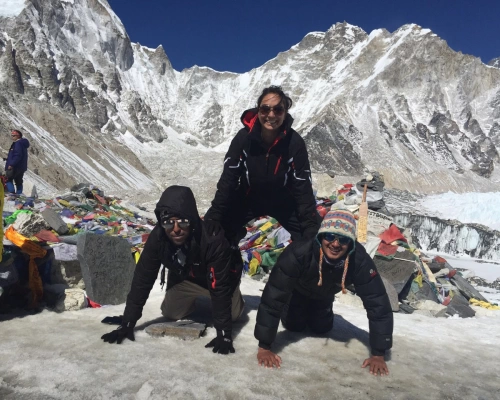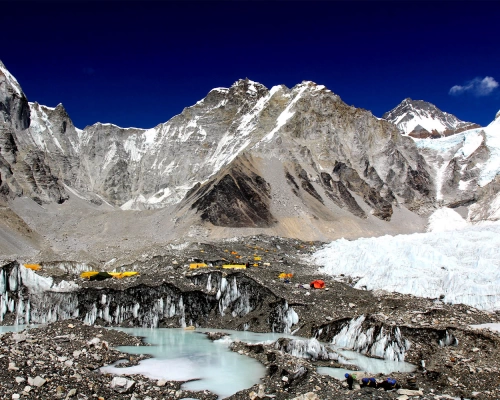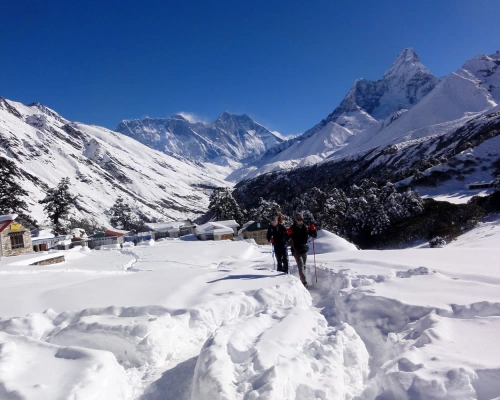How Safe is Sleeping at Everest Base Camp Overnight Trek?
Safety comes first when you are traveling over 5,000 meters. Further, while sleeping at Everest Base Camp, it has to be with utmost comfort and safety.
To ensure health safety in the first place, we provide oxygen supplements with masks in case of an emergency. Our chefs serve you quality food for an overnight sleep at EBC.
Warm sleeping bags and blankets are also crucial to keep you warm all night. Not to worry, we will manage each item that keeps you warm and safe.
Our seasoned guides with more than a decade of guiding experience will be there for your service.
Best Time for Sleeping at Everest Base Camp Overnight Trek
All trekkers with a veritable enthusiasm to trek to Everest Base Camp might already know that Spring and Autumn mark the best time to Sleep at Everest Base Camp Overnight trek. During these months, the rains are not as heavy as some other months of monsoon nor is the temperature unbearably cold like in the winter.
March, April, and May- which mark the spring season- are the three months when expeditionists visit the Everest Base Camp and set up their tents before marching off to the highest peak in the world. Another season where you can enjoy the Everest Base Camp Overnight Trek is the months of autumn- September, October, and November.
For more details, read our detailed blog on the best time to travel in the Everest region.
Meals and Accommodation in Sleeping Overnight at EBC Trek
We make sure that you get adequate nutritious food and comfortable accommodation on the entire Sleeping at Everest Base Camp Overnight Trek.
The arrangements at Everest Base Camp are of the highest quality since expedition teams want to ensure maximum service to mountaineers. You'll also be enjoying the same luxury that they get before their important journey. While staying at the base camp, our kitchen staff prepares nutritious and warm meals for you. The food you'll eat at base camp includes cereals, pancakes, bread, noodles, rice, fruits, vegetables, warm soups, etc. All in all, services at the base camp are comparable to a 3-star service provider, which is more than what anyone could ask for in the remote location.
On the trek from Lukla to Gorak Shep, you'll stay overnight at tea houses. The tea houses offer a variety of decent meals. The trek package includes breakfast, lunch, and dinner.
Tea, coffee, toast, omelet, porridge with honey, soups, and other foods are breakfast items for you. For lunch, you'll get Thukpa, Spaghetti, Pizza, Sandwiches, and Nepali Dal Bhat, which contains rice, vegetables, lentil soups, and pickles. The meal menu for dinner will be similar to that of lunch.
While you stay in Kathmandu, you can enjoy the meals of your choice. You are hosted at a 3-star hotel in Kathmandu. We offer breakfast at the hotel you're hosted in Kathmandu.
Safety Equipment while Sleeping at Everest Base Camp Trek for Overnight
Sleeping at Everest Base Camp overnight can be risky without proper plans and logistics. Hence, to minimize the potential risk, Sublime Trails commits to 100% arrangements of safety materials like bottled oxygen, nutritious meals, warm overnight sleeping bags, tents at secured places, far from avalanche-prone areas, and much more.
Our primary concern is the safety and security of clients joining the Overnight Sleeping at Everest Base Camp trek. Hence, our expert guides and porters will assist you throughout the trip. If necessary, proper medical attention during emergencies with helicopter evacuation will always be within reach.
The porters will carry up to 15kg backpacks and ensure that your gear is safe. You can carry important stuff like documents, money, passports, cellular devices, and gadgets on your own for better safety and a worry-less hike.
Baggage weight limit for airlines and porters
We recommend you carry a medium-lightweight backpack that can accommodate approximately 10kg of gear and essentials. You don't need a porter if you include your bags within this weight limit and can take the backpack the entire trekking period. But if you can't, then you have to get a porter.
In the Sleeping at Everest Base Camp trek, we provide one porter for two trekkers. In this way, a porter carries not more than 30kg of two on shared. But, if the weight limit crosses 30 kilograms, you must hire a new porter, and the expense will increase. If you need help packing for the trek, read our detailed packing checklist for Everest trekking.
Similarly, the airlines allow a 15kg baggage weight limit for trekkers at the airport, 10kg on a backpack, and 5kg on hand carry. For weight exceeding the limit, airlines charge fees as per their policies.
Make a decent plan on what to carry and what not to carry based on your preferences.
Trek Difficulty
Trekking to Everest Base Camp and sleeping overnight at the base camp is easy to moderate grade difficulty if you prepare well for the EBC trek.
The trek from Lukla to Phakding and Namche Bazaar is easy and comfortable. The well-maintained trekking trails with a single route are easy to hike and navigate. The acclimatization at Namche Bazaar prepares you well for future hikes to Tengboche, Dingboche, and Lobuche. The rugged landscape of Lobuche, Gorak Shep, and base camp is moderately challenging. The fatigue from the previous day's hike and low oxygen levels will make you feel tired.
You won't have difficulty accommodating at the base camp in tented camps. Our trek crew with the best kitchen staff will prepare meals and make you feel at home.
Flight Delays and Transportation
We operate Sleeping at Everest Base Camp Overnight Trek in Autumn and Spring. During these two seasons, the weather clears, the temperature becomes mild, and significantly, no rainy days. In such ideal conditions, the Kathmandu Lukla flight takes place every day.
Flight delay happens during high air traffic, but there's a rare chance of flight cancellation in Spring and Autumn. Plan one or two extra days as buffer days for possible bad weather conditions. But for rest, you'll be fine.
Porters and mules carry all the backpacks and items for camping at Everest Base Camp. If you cannot hike due to tiredness, you can get the horse ride service from any point in Khumbu to Everest Base Camp.
As a complimentary ride, upon arrival and departure, a Sublime Trails representative will pick you up and drop you at/from your hotel.
Guides and Porters Safety
Sublime Trails employs fit and experienced guides for Everest trekking. Our porters and guides have health insurance covering medical emergencies and issues. As we commit to the safety of clients joining the Sleeping at Everest Base Camp Trek, we also prioritize the well-being of our guides and porters.
The guides are required to be on a call with the management team at the end of every day. This allows the management team to ascertain the mental and physical state of the team and guests on the Sleeping at Everest Base Camp Trek. The daily call also lets the management team hold discussions if the trek isn't going as planned, which greatly improves the team's reaction time.
Additionally, both our guides and guests have a 24-hour call line they can access to check up with their family and friends. Their family and friends can also contact the Sublime Trails office to take note of their condition.
Altitude sickness and prevention
You may experience some symptoms of altitude sickness like headaches, nausea, vomiting, dizziness, shortness of breath, etc during the Sleeping at Everest Base Camp Trek.
With common medicines like paracetamol, trekkers can dodge these symptoms. But for some, the body reacts differently to the altitude, and signs grow severe.
If you feel discomfort with these symptoms, we encourage you to talk to your trek guide. Your trek guide will act according to your health issues. If you recover with essential medications, guides will take care of you. But, if things get serious, the manual calls a helicopter for emergency evacuation.
Avoid drinking caffeinated and alcoholic beverages throughout the trek to prevent altitude sickness. Also, drinking plenty of lukewarm water and eating adequate meals help you to avoid high altitude sickness. If you want to take some medicines, we recommend carrying one or two tablets of Diamox, which allows trekkers to prevent altitude sickness.
At Everest Base Camp, while accommodating and sleeping for a day, you'll get bottled oxygen if you have difficulty breathing.
Travel Insurance
Travel Insurance is the most important document you must carry while trekking at high altitudes. Trekkers joining the group for Sleeping at Everest Base Camp Trek in Autumn must have a copy of the insurance document.
In unforeseeable situations during altitude sickness and health injuries, helicopter evacuations can only be the last hope. So, to call a helicopter on time, you just need travel insurance. Decent travel insurance covers the expense of helicopter and medication bills. So, travel insurance lets you enjoy a worry-less hike on the Everest trekking route.
Respect for ethnic cultures and values
Sherpa people are inhabitants of the Khumbu region. These people's lifestyle, culture, tradition, festivals, and values lure thousands of trekkers to trek to Everest and witness these elements. Some festivals like Mani Rimdu and Buddha Purnima at Tengboche, for which many trekkers plan their visit in August.
There's no denying that excessive tourism and trekking in this region have caused some imbalances environmentally, culturally, and economically. Increased human activity in these areas has brought cultural differences. Hence, to lower the conflict between cultures and lessen the environmental impact, we encourage you to practice sustainable trekking and respect the locals.
In most situations, these people become helpful and assist you on multiple occasions. Passing a smile to locals won't cost you a penny. But, it creates peace and love among travelers and locals.
Tip for Trek Guides and Porters
At the successful completion of Overnight Sleeping at Everest Base Camp Trek, you are expected to tip the trek guides and porters. You can list them as much as you like, but the common practice among trekkers is tipping 10% of the trek cost to the guide and porters. They expect some tips from you at the end of the trip.
Your tip can be a hope of encouragement for them to continue working and assisting trekkers to reach the wonderful place of Everest.
Related Trips in the Everest Region
Everest Base Camp Luxury Trek | Classic EBC Trek | Everest Helicopter Tour | EBC Trek with Helicopter Return | Scenic Mount Everest Sightseeing Flight














